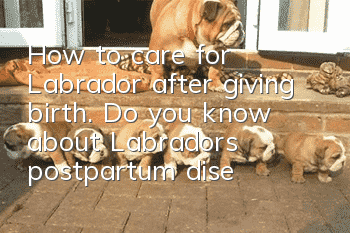How to care for Labrador after giving birth. Do you know about Labrador’s postpartum diseases?

Labrador postpartum care should be thorough
1. Wipe the dirty parts of the dog’s body with warm water, especially the vagina. And wipe the breast and surrounding areas clean with warm water, and let the puppies get close to the dog's breast. At this time, the dog will instinctively lick the body of the puppy, and the puppy will suck the breast milk, so that every dog can drink as much as possible. Only through breast milk can the invisible antibodies from the mother dog be obtained, which enhances the puppy's resistance to disease. 2. Give the dog a quiet environment after delivery. The dog's maternal nature is also the strongest at this time, so do not let strangers or other animals approach it. , to prevent the female dog from attacking the puppies. 3. At the same time, the dog should be given high-calorie, high-protein, high-fat and calcium-rich foods, such as puppy dog food, and add an appropriate amount of calcium powder and Xiuguanfukangle to regulate the intestinal function of the female dog and accelerate the recovery of childbirth. .Labradors may suffer from mastitis after giving birth
Mastitis refers to one or more mammary glands being infected by bacteria, and the cause of the infection can be ascending infection of the nipple; or infection due to trauma to the mammary gland. If mastitis infection is not properly treated, it may cause a fatal systemic infection. If the dog is infected with mastitis, the dog usually has a loss of appetite, poor energy, and neglects to take care of the puppy. The breasts are hard, swollen and warm when touched with your hands. Most dogs will feel pain, and pus-like blood-containing fluid will flow out of the nipples. In severe infections, there will be lesions such as thick sores or gangrene on the breasts, and the dog will have fever and dehydration.Treatment methods for mastitis in Labrador
Acute mastitis should be treated with antibiotics as early as possible, and the whole litter of nursing puppies should be weaned and artificially raised. The affected breasts are massaged and expressed several times a day. After expression, aqueous antibiotics are injected into the breast pool through the nipple duct, 2 to 3 times a day. Antibiotics should be broad-spectrum, such as penicillin, streptomycin, and ampicillin. Furans and sulfa drugs can also be used. For those with breast abscess, the pus can be drained by incision at the softest part and flushed with penicillin and saline.Labradors may suffer from obstetric fever after delivery
The reason is that postpartum hypocalcemia leads to tonic and clonic contractions of skeletal muscles. This situation can be fatal. Please anesthesia. You must pay attention! When the puppies are ten or twenty days old, the puppies suck too much milk, and the bitches lose serious calcium. If they do not receive an appropriate amount of calcium supplement after delivery, the bitches are prone to childbirth fever. Symptoms: (1) The dog will become restless and nervous; (2) Kick, breathe faster, and whine; (3) Stiffness in walking posture and movement disorder; (4) Muscle tremors and twitching; (5) But it has just started 8-12 hours after the onset of symptoms, symptoms of potentially fatal muscle stiffness, straightening, and falling to the ground are usually accompanied by a rise in body temperature and hypotension.Sugar and pupils are dilated and unresponsive to light.
Treatment methods for Labrador suffering from childbirth fever
1. Antibacterial and anti-inflammatory, large doses of antibiotics can be used. 2. Inject glucose sodium chloride injection, vitamin C, and sodium hydrogen phosphate solution intravenously to correct dehydration and acidosis. Labradors will suffer from calcium deficiency after giving birth
(1) Diet is an essential thing every day. If you want to prevent calcium deficiency in dogs, you must start with their daily diet. In addition to giving If your dog eats a single type of dog food, you should also pay attention to the dog's reasonable diet. The calcium content in dog food is very small, and some even have no calcium content. You can give your dog some foods with higher calcium content, such as dried shrimps and beans. You can also make products and give your dog more vegetables and fruits to supplement vitamins. When supplementing calcium for your dog, you should pay attention to the vitamin intake so that your dog can better absorb calcium. (2) In the first few days, feeding should be based on the principle of "eat less and more meals". Generally, broth, porridge, milk and other foods that are easy to digest and absorb are the main ones. It can be fed 3 to 4 times a day. In addition to appropriately increasing concentrates and vegetables, more meat, liver, bone soup, broth, eggs and milk should be fed to supplement calcium for the female dog. (3) In order to achieve a better purpose of calcium supplementation, you can also choose professional pet calcium supplement products. In terms of effectiveness, liquid calcium is now generally recognized, followed by calcium powder, and finally calcium tablets. (4) In addition, giving your dog some sunshine can also help your dog absorb calcium better. However, you should not bask in the sun for too long to prevent your dog from getting sunburned or suffering from heatstroke.Lochia in Labradors after delivery
After the baby is delivered, the residual blood and turbid fluid left in the uterus is called "lochia". The main causes of postpartum lochia are weak uterine contractions, uterine fatigue, endocrine disorders, local inflammation or retained placenta. Lochia lasts for about a week after the dog gives birth. In the early stage, the lochia contains blood and is red; in the middle stage, it turns to light yellow, and in the later stage, it becomes transparent and colorless, and then stops being discharged. If it cannot be cleared for a long time or there is an abnormal stench, it indicates that there are pathological changes in the uterus.Treatment method for postpartum lochia in Labrador
When breastfeeding, you usually lie on your side. The vulva stays close to the bedding for a long time, so it is more likely to cause infection. Parents should regularly disinfect and clean the dog's mother's vulva and perineum. Lochia contains a large amount of blood and other substances that are easy for bacteria to grow, so it can cause ascending infection and must be wiped clean in time. Clinically, 0.1% potassium permanganate water is commonly used as a cleaning solution because it has strong oxidizing effect and is non-irritating. Dogs with lochia and vaginal bleeding need to be injected with postpartum fast-care or Houttuynia cordata injection to promote uterine contraction.Going to the hospital is just like this, maybe the name is different. You can eat motherwort and brown sugar water after giving birth, which can warm and protect the uterus and help the mother dog recover quickly. If the above situation occurs, please take your pet to the hospital for treatment as soon as possible. The doctor will give you a slow intravenous injection to improve the hypocalcemia. If the body temperature is too high, you can use cold water immersion and an electric fan to cool down to stabilize the dog's life signs. In the future lactation period, sufficient calcium should be supplemented. Random articles
- How to choose dog shower gel? What should you pay attention to when bathing your dog?
- What should I do if Corgi doesn’t eat? The reason why Corgi doesn’t eat may be because of illness.
- What are the shortcomings of Samoyed? There is also a little devil living inside the smiling angel.
- What should you pay attention to when raising a corgi? Do you know these?
- Which dogs are more loyal and suitable to be kept as companion dogs at home?
- How many personality types does Teddy have? Which one does your dog belong to?
- What are the disadvantages and advantages of Teddy? Think about it before raising it.
- How to get rid of mites in Samoyed? A beginner’s guide to getting rid of mites in Samoyed
- How to train a Samoyed to be a guardian? Dog guardian training guide
- How to tell whether a French bulldog is pure or not? Six tricks to develop dazzling eyes



